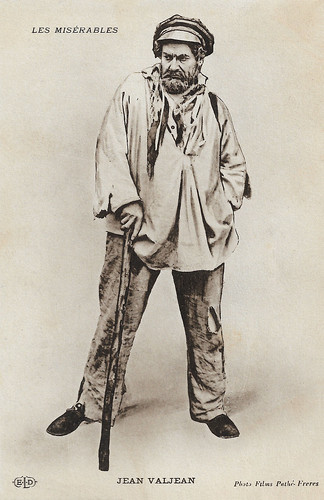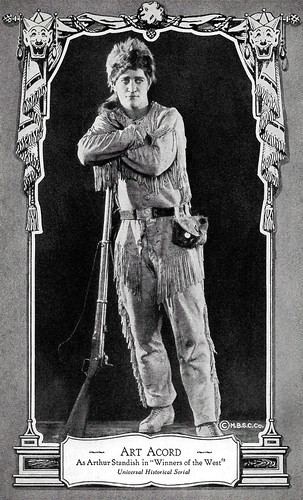
French singing postcard by Musicarte, Paris, no. 501. Photo: Alec Guinness in The Bridge on the River Kwai (David Lean, 1957). Caption: Succès. One can use this singing postcard (in French: La Carte qui chante) as a record 45 R.P.M. The song is 'Colonel Bogey' by Oscar Denayer and his Orchestra.
English actor Sir Alec Guinness (1914–2000) was one of the most versatile and subtle actors of his time, in the cinema and on television no less than on the stage. He was master of disguise in several of the classic Ealing Comedies, including Kind Hearts and Coronets (1949) in which he played eight different characters. He later won the Academy Award for Best Actor for his role as Colonel Nicholson in The Bridge on the River Kwai (1957), and he is probably even better known for playing Obi-Wan Kenobi in the original Star Wars trilogy (1977-1983).

French postcard by ELD. Photo: Films Pathé-Frères. Henry Krauss in Les Misérables (Albert Capellani, 1913). Sent by mail in 1916.
French actor and director Henry Krauss (1866-1935) was a veteran of European cinema. From 1908 on, he starred in several powerful character roles in early silent films.

Spanish collectors card in the Artistas de Cine Series by Chocolate Amattler, Barcelona, no. 34. Image: Martinez Surroca.
Georges Biscot (1886-1945) was a popular French music-hall and revue singer and actor, who also knew a career in French silent and sound film.

American Arcade card. Photo: Evans, L.A.
American silent film actor, comedian Roscoe ‘Fatty’ Arbuckle (1887-1933) was one of the most popular silent stars of the 1910s. He started at the Selig Polyscope and moved to Keystone Studios, where he worked with Mabel Normand and Harold Lloyd. Arbuckle mentored Charlie Chaplin and discovered Buster Keaton and Bob Hope. In 1920, he signed a contract with Paramount Pictures for US$1 million. Between November 1921 and April 1922, Arbuckle was the defendant in three widely publicised trials for the rape and manslaughter of actress Virginia Rappe. Following the trials, his films were banned and he was publicly ostracized. Arbuckle only later worked as a film director under the alias William Goodrich. He was finally able to return to acting, making short two-reel comedies in 1932 for Warner Bros. He died in his sleep of a heart attack in 1933 at age 46, reportedly on the same day he signed a contract with Warner Brothers to make a feature film.

American postcard by M.B.S.C. Co. Photo: Universal. Frank Mayo as Anthony Moreland in Lasca (Norman Dawn, 1919).
Frank Mayo (1889–1963) was an American actor, who appeared in 310 films between 1911 and 1949. He was one of the major stars of the American silent film in the 1910s and 1920s. He also worked as a director.

American postcard by Max B. Sheffer Card Co., Chicago (M.B.S.C.Co.). Photo: Universal. Art Acord as Arthur Standish in Winners of the West (Edward Laemmle, 1921). Caption: Universal Historical Serial.
American silent star Art Acord (1890-1931) was known as "The Cowpuncher King". He was a rodeo champion and as a film star, he was known for such Westerns as The White Horseman (1921), The Set-Up (1926), and Set Free (1927).

German postcard by Ross Verlag, no. 3839/2, 1928-1929. Photo: Max Munn Autrey / Fox Film.
Madge Bellamy (1899-1990) was a beautiful and temperamental leading lady of the silent era, known for such classics as John Ford's first Western The Iron Horse (1924). She appeared in about fifty silent films and also in a dozen sound films, including the cult favourite White Zombie (1932). By the late 1930s, her film career had virtually ended, but in 1943 she became again fodder for the press when she was arrested for shooting her former lover.

French postcard by Europe, no. 655. Photo: First National / Arta Film.
American actress Colleen Moore (1899-1988) was a star of the silent screen who appeared in about 100 films beginning in 1917. During the 1920s, she put her stamp on American social history, creating in dozens of films the image of the wide-eyed, insouciant flapper with her bobbed hair and short skirts.

German postcard by Ross Verlag, no. 8851/1, 1933-1934. Photo: Paramount.
Marlene Dietrich (1901-1992) was the first German actress who became successful in Hollywood. Throughout her long career, she constantly re-invented herself. In 1920s Berlin, she started as a cabaret singer, chorus girl, and film actress. In the 1930s, she became a Hollywood star, then a World War II frontline entertainer, and finally, she was an international stage show performer from the 1950s till the 1970s. Now we remember her as one of the icons of the 20th century.

Big German card by Ross Verlag. Photo: Paramount.
American actress and singer Dorothy Lamour (1914-1996) is best remembered for appearing in the Road to... comedies, starring Bing Crosby and Bob Hope. During World War II, Lamour was among the most popular pin-up girls among American servicemen.

Vintage postcard. Photo: Vivien Leigh and Laurence Olivier in Lady Hamilton (Alexander Korda, 1941).
Extraordinarily beautiful British actress Vivien Leigh (1913-1967) won two Academy Awards for playing ‘Southern belles’: Scarlett O'Hara in Gone with the Wind (1939) and Blanche DuBois in A Streetcar Named Desire (1951). On stage, she starred – often with her husband, Laurence Olivier - in parts that ranged from the heroines of Noël Coward and George Bernard Shaw comedies to Shakespearean characters like Ophelia, Juliet, and Lady Macbeth.

French postcard by J. Henzen, Paris / C.F., Paris. Caption: Marcel Cerdan, European Champion Middle Weight.
World boxing champion Marcel Cerdan (1916-1949)' nicknamed ‘The Casablanca Clouter’, was France's greatest boxer. His life was marked by his sporting achievements, his passionate love affair with Édith Piaf, and his tragic death. He appeared in two films and was portrayed in two films.

Belgian postcard by Nieuwe Merksemsche Chocolaterie S.P.R.L., Merksem (Anvers). Photo: Republic Pictures. Robert 'Bobby' Blake as Little Hunter.
American actor Robert Blake (1933) began acting as a child in the Little Rascals series (1939-1944) and the Red Ryder Westerns, as Little Beaver and later Little Hunter. Later, he became known for his stunning portrayal of killer Perry Smith in the film In Cold Blood (1966) and as street-wise detective Baretta in the TV series Baretta (1975-1978).

Austrian postcard by Verlag Hubmann (HDH Verlag), Wien (Vienna), no. 2948. Gunnar Möller in Hollandmädel/Dutch Girl (J.A. Hübler-Kahla, 1953).
German actor Gunnar Möller (1928-2017) was one of the stars of the Wirtschaftswunder Kino of the 1950s. He appeared in over 160 film and television productions between 1940 and 2016. He later turned to character roles and worked for a number of years in England.

Yugoslavian postcard by Studio Sombor, no. 264.
Exotic American actress Debra Paget (1933) is perhaps best known for Cecil B. DeMille's epic The Ten Commandments (1956) and Elvis Presley’s film debut Love Me Tender (1956). Later, she had a career in Europe too. In Germany, she starred in Fritz Lang's two-film adventure saga Der Tiger von Eschnapur/The Tiger of Eschnapur (1959) and Das Indische Grabmal/The Indian Tomb (1960) and in Italy, she also made a pair of films.

Swedish postcard by Äkta handkolorerade fotokort, no. 20014.
Husky, darkly handsome Steve Cochran (1917-1965) was an American film, television, and stage actor, who often played boxers and gangsters during the 1940s and 1950s. One of his best-known roles is the troubled drifter in Michelangelo Antonioni's Il Grido (1957), produced in Italy.

French postcard. Photo: Pierre et Gilles. Laurent Chemda, Eliane Pine Carrington and Nini Crépon in Le Traité du Hasard/The Treaty of Chance (Patrick Mimouni, 1998).
Le Traité du Hasard/The Treaty of Chance (Patrick Mimouni, 1998) is a little-known Parisian gay dramatic comedy. It chronicles the lives of a small band of "crazy" homosexuals in Paris, between 1995 and 1997. They are confronted with seropositivity, each in his own way. One of them will develop the disease, but without succumbing to it, thanks to the arrival of triple therapies.
The most notable reason for acquiring this postcard was the wonderful poster image by Pierre et Gilles. Pierre et Gilles is the pseudonym of a couple of French visual artists formed by the photographer Pierre Commoy, (1950) and the painter Gilles Blanchard (1953). Since 1976, they have been developing four-handed works between painting and photography. Their paintings feature their relatives, anonymous or famous, in sophisticated settings built life-size in the workshop. Once the photograph is printed on canvas, a meticulous painting work begins. They have created a unique iconography exploring the border between the history of art and popular culture. They designed several film 'affiches', including posters for Les Amants criminels/Criminal lovers (François Ozon, 1999), and Presque Rien/Almost Nothing (Sébastien Lifshitz, 2000).
3 comments:
An interesting mix of cards, I, like you have missed the postcard fairs although I only attend those held locally and have had to settle for eBay, Delcampe, ebid and Etsy, perhaps the upside is that although I mainly collect Gabrielle Ray ephemera which I tend stick to at the fairs, using the auction sites has opened up new horizons to other actresses which has added to my collections and interest - every cloud as they say but I am looking forward to their resumption as a seller and buyer.
Thanks for your comment. We totally agree. And if you ever want to do a guest post at EFSP on Gabrielle Ray, please, let us know.
Thank you that's most kind, I have almost finished a chapter about Amy Webster from the book I'm trying to write about Miss Ray, just a few corrections then I'll send it for your consideration. Regards, Chris
Post a Comment